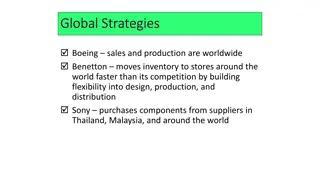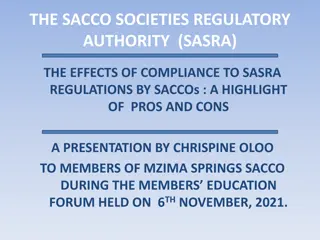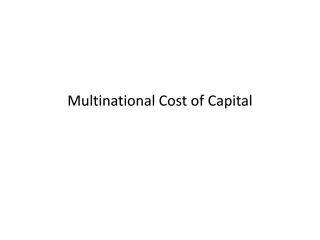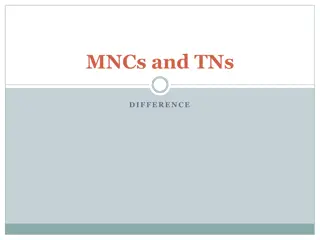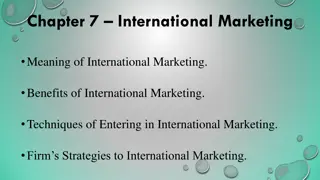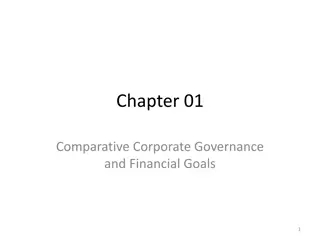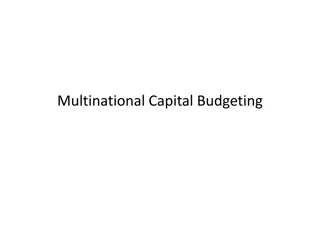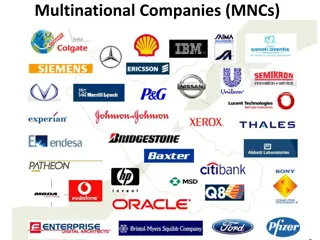Pros and Cons of Multinational Corporations
Multinational corporations bring benefits like best practices, innovation, cultural awareness, job opportunities, and improved infrastructure. However, they also have drawbacks such as monopolistic practices, harm to the environment, and draining local resources. Understanding the advantages and disadvantages of MNCs is crucial for evaluating their impact on economies and societies.
Download Presentation

Please find below an Image/Link to download the presentation.
The content on the website is provided AS IS for your information and personal use only. It may not be sold, licensed, or shared on other websites without obtaining consent from the author. Download presentation by click this link. If you encounter any issues during the download, it is possible that the publisher has removed the file from their server.
E N D
Presentation Transcript
Multinational Corporation or transnational companies A multinational corporation has facilities and other assets in at least one country other than its own country Such companies have offices and/or factories in different countries and usually have a centralized head office where they coordinate global management
MNCs in India Siemans GE India Stanchart Hindustan Unilever Nestle Coca-Cola etc
Advantages of MNCs 1. Multinational corporations are often responsible for today s best practices. 2. Innovation happens because of the investments made by multinational corporations. 3. The world has more cultural awareness because of multinational corporations.
4. Multinational companies focus on consistency for the consumer. 5. Diversification becomes possible because of multinational corporations. 6. Local infrastructures improve with the presence of multinational corporations. 7. Multinational companies offer employment opportunities at the local level.
8. The import-export market is present because of multinational corporations. 9. Multinational companies reduce the need for foreign aid. 10. Capital inflows occur because of the presence of multinational corporations.
Disadvantages of MNCs 1. Multinational corporations can use their structure to form monopolistic markets. 2. Because of their size, multinational corporations put SMEs out of business. 3. Multinational corporations often take advantage of the international standard of living. 4. Political corruption typically rises with the influence of a multinational corporation.
5. Multinational corporations can cause harm to the environment. 6. Profits often go back to the multinational company instead of staying in the local market. 7. Nothing stops a multinational company from importing their skilled labor. 8. Multinational corporations remove raw materials from the local economy.
9. Individual influences are virtually impossible to create with multinational corporations. 10. It creates a dependency on the business that can be unhealthy for an economy.
Indias Foreign Direct Investment Policy and Trends Since 1991 the Indian Government has promoted the flow of FDI and made India an attractive destination for foreign investors. India s foreign policy has undergone many changes since 1991, though the basic direction of the policy remain the same. 1. New Industrial policy 1991 up to 51% of foreign ownership in 34 priority sectors
2. FDI Routes automatic and government 3. The Department of Industrial Policy and Promotion responsible for formulation of FDI policy and help increase FDI flow into the country. Also it helps in solving the problems faced by foreign investors. 4. Foreign Investment Implementations Authority Fast approval of FDI
4. Foreign Investment Promotion Board 5. FDI policy 2017 (a) Abolition of Foreign Investment Promotion Board to ease out the FDI flow.. After this the approval of FDI flow in 11 sectors was approved for which Government approval was needed. (b) Introduction of Foreign Investment Facilitation Portal online clearance of application .Government route
(c) Identification of competitive authorities ..Select the competent authority to approve FDI. (d) Introduction of standard operating procedure (e) Issue of convertible notes by start ups as debt instruments (f) 100 % FDI limit in civil aviation, and 100 % FDI under Govt approval route for retail trading,
6. Recent FDI trends * Marginal improvement in FDI equity investment in 2017 from 2016. Highest FDI equity flow in telecommunication Highest flow of FDI is from Mauritius followed by Singapore, Netherlands, USA and Japan


